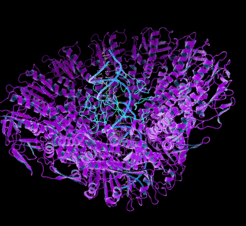Modelling the Phi 29 Head-Tail Connector

Bacteriophage Φ 29 infects the bacterium Bacillus subtilis. During infection, the newly synthesized DNA has to be translocated into an empty viral capsid. For this purpose, the virus produces a packaging machine, consisting of a terminase enzyme and a head-tail connector. This machine packs a 19 kbp DNA molecule to near crystal density within 5.5 min.
The head-tail connector plays a main role during packaging. There is evidence that it acts as a valve, preventing the packed DNA from leaving the capsid. Alternatively, it might actively promote packaging. Our main goal is to characterize the mechanical properties of the connector and the relation between DNA translocation and connector rotation in order to distinguish between the different proposed connector functions.

